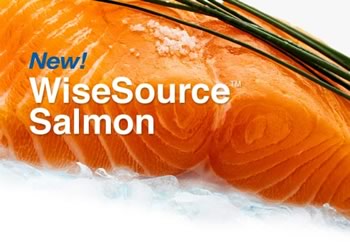The Seaweed and Integrated Multi-Trophic Aquaculture (IMTA) Research Laboratory of
Dr. Thierry Chopin
IMTA salmon goes commercial...
... as the largest food distributor in Canada, Loblaw, launched WiseSource™ Salmon in association with its supplier, True North Salmon Company, and the scientific collaboration of the IMTA research team in New Brunswick.
Loblaw made the announcement on January 27, 2011: “Loblaw offers WiseSource™ Salmon: a new option and the next step forward in the journey toward 100 per cent sustainable salmon”.PDF
More information can be found on the Loblaw website.
This announcement made some waves, generating at least 39 articles in the business and seafood media. Wency Leung wrote an article in The Globe and Mail, whose title in the electronic version on February 1, 2011, was “Environmentalists skeptical of Loblaw’s boost for salmon farming” and appeared the next day in the hard copy newspaper as “Atlantic salmon get a shot in the farm”.
Thierry Chopin was interviewed on CBC Television “New Brunswick at 6:00” by Rachel Cave, on February 3, 2011.
He was also interviewed on CBC Radio “Information Morning Saint John” by Steven Webb, on
February 4, 2011,
and on SRC French speaking Television “Téléjournal Acadie” by Thomas Daigle, on February 6,
2011.
The cultivation of extractive species, such as shellfish (foreground) and seaweeds (background), in an Integrated Multi-Trophic Aquaculture (IMTA) setting is what differentiates the WiseSource™ Salmon produced by True North Salmon Company and distributed by Loblaw. (Photo: Thierry Chopin)
Thierry Chopin commented that “a very important point is that, as indicated by Loblaw, we are on a journey toward 100 per cent aquaculture sustainability. This means that we have not arrived there yet, but we are doing something to get closer. We have a producer, True North Salmon Company, adopting an innovative practice, we have Canada’s largest food distributor, Loblaw, leveraging its buying power to influence the evolution of aquaculture, and we, the IMTA R&D team, are in the middle to help with our R&D to scale IMTA up to commercialization. The stars are finally aligned (each of us needs interactions with and incentives from the others to complete the circle). That is exactly where we are: we are in a very interesting case of ecosystem responsibility from the egg, through science, to the plate! We are all working on an innovative initiative to drive sustainability-based transformational changes.”
The IMTA research team in New Brunswick would like to thank the continuous support, since 2001, of the Government of Canada (through the Atlantic Canada Opportunities Agency’s Atlantic Innovation Fund, the Natural Sciences and Engineering Research Council, Fisheries and Oceans Canada, and the Canadian Food Inspection Agency), the New Brunswick Innovation Foundation, the New Brunswick Department of Agriculture, Aquaculture and Fisheries, the University of New Brunswick, and its industrial partner, Cooke Aquaculture Inc. The concept of integrated aquaculture in the Bay of Fundy was first mentioned in 1995. Experimental work started in 2001. Integrated Multi-Trophic Aquaculture, and its acronym IMTA, were first coined in 2004 at a workshop in Saint John, New Brunswick (to date, the term “IMTA” has been used in more than 100 scientific publications). First sales of New Brunswick IMTA products (seaweeds and mussels) started in 2009. What a journey along the Research & Development & Commercialization (R&D&C) continuum over the last 15 years! Thanks to the perseverance and dedication of all involved to arrive to this significant milestone in the development and adoption of IMTA as an environmentally, economically and societally responsible aquaculture practice.

 Accessible Version
Accessible Version